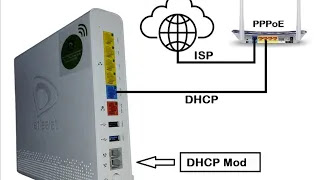Etisalat Arcadyan Router Configuration
Network System
August 06, 2024
Etisalat Arcadyan Router Configuration | configure to DHCP Mod and access point
Configuring your Etisalat Arcadyan router involves accessing the router's web interface and making the necessary changes to your network settings. Here's a step-by-step guide to help you with the configuration:
Step 1: Connect to the Router
Power on your router: Ensure your Arcadyan router is powered on and connected to your computer or device via Ethernet cable or Wi-Fi.
Connect to the router’s network: If using Wi-Fi, connect your device to the Wi-Fi network broadcast by your Arcadyan router.
Step 2: Access the Router's Web Interface
Open a web browser: Launch a web browser on your connected device (Chrome, Firefox, Edge, etc.).
Enter the router’s IP address: Type the router's IP address into the browser's address bar. The default IP address for most Arcadyan routers is usually 192.168.1.1 or 192.168.0.1.
Step 3: Log in to the Router
Enter the login credentials: You will be prompted to enter a username and password. The default credentials are often:
Username: admin
Password: admin or password
If these don't work, check the router’s manual or the label on the router for the correct login information.
Step 4: Configure Basic Settings
Change the SSID (Wi-Fi network name): Navigate to the wireless settings section and set a new SSID (network name) for your Wi-Fi.
Set a Wi-Fi password: Ensure your Wi-Fi network is secured by setting a strong password. This is usually found under the security or wireless security settings.
Step 5: Configure Advanced Settings
Network Mode: Choose the appropriate wireless mode (e.g., 802.11n, 802.11ac) based on your device compatibility.
Channel Selection: Set the Wi-Fi channel. You can leave it on Auto or choose a specific channel to reduce interference.
DHCP Settings: Configure DHCP settings if you need to set specific IP ranges for your network.
Step 6: Save and Reboot
Save your settings: After making the necessary changes, ensure you save the settings. There is usually a 'Save' or 'Apply' button at the bottom of the configuration page.
Reboot the router: Some settings might require the router to be rebooted. You can either power cycle the router or use the reboot option within the web interface.
Additional Tips
Firmware Updates: Check if there are any firmware updates available for your router to ensure you have the latest features and security patches.
Backup Settings: If your router has the option, back up your current settings before making changes. This allows you to restore them if something goes wrong.
Contact Support: If you encounter issues or need specific configurations, refer to the router's manual or contact Etisalat customer support for assistance.
You may like these posts
Subscribe Us
Most Popular

Download MikroTik Mikhmon Voucher Template
January 19, 2025

Mikrotik Hotspot Configuration
August 06, 2024

Etisalat Arcadyan Router Configuration
August 06, 2024
Categories
Sample Text
Blog Archive
-
▼
2024
(10)
-
▼
August
(10)
- How to limit speed for each user in Mikrotik Route...
- All traffic fine enquiries, check and payment info...
- Automatic Reboot Mikrotik Router Board | Using the...
- Windows 10/11 Photo Image Preview is not showing |...
- Hotspot will generate a voucher server for the use...
- Mikrotik Hotspot Configuration
- Mikrotik Couldn't Remove file flash Permission denied
- TPLINK WIFI Router Configuration
- Etisalat Arcadyan Router Configuration
- UAE Traffic fines Inquiry and Payment information
-
▼
August
(10)
Popular Posts
-
Etisalat Arcadyan Router Configuration | configure to DHCP Mod and access point Configuring your Etisalat Arcadyan router involves ac...
-
MikroTik Mikhmon Voucher Template Prepare Mikhmon Environment Install Mikhmon : Ensure that Mikhmon is installed and connected to your Mik...
-
UAE Traffic fines Inquiry and Payment information In the UAE, traffic fines can be checked and paid online through various channels, i...
-
Click Here to Download File Configuring a Cisco router involves several steps. Here are the general steps to follow: Connect to ...
-
Windows 10/11 Photo Image Preview is not showing | on Laptop and PC ونڈوز 10/11 فوٹو امیج کا پیش نظارہ نہیں دکھا رہا ہے | لیپ ٹاپ اور پی سی ...
-
Mikhmon generator and how to create voucher designs Creating a Hotspot Voucher Server using Mikhmon (Mikrotik Hotspot Monitor) allows you ...
-
How to TPLINK WIFI Router Configuration | DHCP Mode Configuring a TP-Link WiFi router in DHCP mode involves several steps. Here’s a...
-
1- Designing a Mikrotik Hotspot login page involves creating a visually appealing and user-friendly interface for users to log in to the W...
Pages
Unordered List
Random Posts
3/random/post-list
Popular Posts

Download MikroTik Mikhmon Voucher Template
January 19, 2025

Mikrotik Hotspot Configuration
August 06, 2024

Etisalat Arcadyan Router Configuration
August 06, 2024











0 Comments
Welcome to My Blog